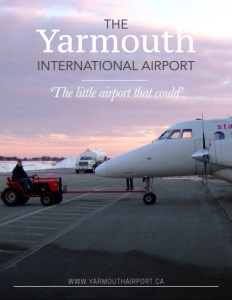The Yarmouth International Airport
‘The little airport that could’
Business View Magazine interviews representatives from the Yarmouth International Airport, as part of our focus on regional Canadian airports.
The Yarmouth International Airport is a commercial and general aviation airport located in Yarmouth County, Nova Scotia, Canada. The Airport was originally constructed in 1937 and was divided into two parts: the West Camp was home to the Royal Canadian Air Force, and the East Camp was part of the British Commonwealth Air Training Plan, used to train pilots for action in World War II. After the war, the airfield switched to public/commercial use when it was transferred to Transport Canada. Regularly scheduled service was started by Trans-Canada Air Lines, which became Air Canada in 1965. Between 1947 and 1987, it operated daily round trips to Halifax, NS, Saint John, NB, and Boston MA.
From 1987, onwards, the Airport was serviced by two smaller, regional carriers – Air Atlantic and Air Nova. In 1999, the owners of Air Atlantic ended its service at Yarmouth; Air Nova ceased operations in 2001; and Air Canada flights into Yarmouth ended in 2003. Since then, several small operators have provided air service between Halifax and Yarmouth at various times. These include Sou’West Air, which covered the route in 2003, and Starlink Airlines, which flew between Halifax, Yarmouth, and Portland, Maine in 2009. The latter lasted less than one year, despite a $2 million provincial government subsidy meant to carry the airline through the first few years of startup. From March 15, 2010 to December 31, 2012, an American company, Twin Cities Air Service, provided service between Yarmouth and Portland with scheduled flights several times a week.
At present, Yarmouth International Airport has no scheduled passenger service and, today, according to Airport Operations Manager, Kris Cann, “The bulk of our business now is charter and corporate business. We’ve also got about 12 GA aircraft based out of the Airport at any given time, and there are probably another half dozen or so in the region that utilize this Airport.”
In 1997, ownership of Yarmouth Airport was transferred from Transport Canada to the Yarmouth Airport Commission Association, a municipal corporation represented by three municipalities: Yarmouth, Argyle, and Clare. The Airport has a modern terminal building and a combined services building, which houses a maintenance garage and vehicles used for clearing runways. There are two asphalt runways: 06/24 at 6,000 feet, and 15/33 at 5,000 feet; two taxiways; and separate parking aprons for both commercial and general aviation. There are 4 RNAV GNSS instrument approaches, a VHF omnidirectional range/distance measuring equipment (VOR/DME), and a non-directional beacon (NDB).
According to Alain Muise, Chief Administrative Officer, Municipality of Argyle, and member of the Yarmouth International Airport Corporation, the Airport generates its own revenue through fuel sales, landing fees, and land and storage rental, but it is “not sufficient to break even, so it receives subsidies from the municipal levels of government. Keep in mind that the majority of these type airports across Canada were federally-owned and operated up until 1997. The Airport was divested to the municipality in 1997, so we’ve been on our own since then. The provincial and federal governments do play a very small role, based on capital requirements, but those requests are on a case-by-case basis, and not necessarily approved. As you might imagine, capital refresh at an airport is not a small undertaking; there are preset funding arrangements, federally, through Transport Canada, but because of our size and magnitude of operations, we don’t fit their criteria for their traditional funding model, so it adds another layer of complexity for our small Airport here in Yarmouth.”
Because Yarmouth Airport lacks a reliable source of major funding, Muise says that it must look elsewhere in order to ensure its future health and longevity. One prospective avenue that the Airport is looking into is the possibility of luring a seafood export business to the property. “Our airspace, our location, is absolutely advantageous,” he notes. “And we see the opportunity for product export right out of Yarmouth. We are located close to the product; lobster, scallops, etc. come right out of the water and are as fresh as any marine product. And we’re right in the middle of a lot of different markets. So, we see our location, combined with the fact that we don’t have heavy passenger traffic in and out all the time, as a real opportunity for commercial growth – sea export being one of the many options.”
However, in order for that possibility to manifest, Muise admits that there would have to be a significant investment in the Airport’s main runway, including a renewed surface, better runway lighting, and even an extension of the runway from its present 6,000 feet to better accommodate heavy cargo traffic. “So, we’re not there yet,” he says. “And it would require a partnership between the layers of government and business to be successful. So, getting the attention of the provincial and federal counterparts to talk about the importance of a long-term investment asset as unique as the Yarmouth Airport would be in our very high interest.”
Muise would also like to see more Airport land leased or sold to commercial entities. “We have surplus area that we haven’t fully taken advantage of,” he reports, “and we believe that there’s a real estate opportunity – whether it’s aviation-related or not – at our Airport that’s quite unique and would allow for some interesting development, particularly in the aerospace sector. Imagine that you’ve got a commercial operation and you’re able to fly in and out at your convenience in an airport that provides wonderful, friendly, one-on-one service in a community that would embrace the kind of economic development that would occur in that area.”
Long-term, Muise also would like to see increased passenger service, which he believes is possible if linked to future development options. “It’s not an impossible task,” he states. “It does require a re-look at how we’ve done it in the past, but there are markets that could potentially make that a sustainable option for us, especially aerospace-related leases and land purchases for commercial development.”
Cann agrees. “We’re a turnkey airport that’s ready for industry,” he remarks. “I think that’s what everybody’s dreams are for the place. We lack the congestion of the majority of the major airports here in Atlantic Canada, and we have the potential for the appropriate aviation industries that would like to do business here.”
“We’re the ‘little airport that could,” adds Muise, in conclusion. “And we’re ready to go. We can provide a high level of service that is a little unique. There is a friendliness component here; you get a personalized service that you just don’t necessarily see in larger, busier environments.”
AT A GLANCE
WHO: Yarmouth International Airport
WHAT: A commercial and general aviation airport
WHERE: Yarmouth County, Nova Scotia, Canada
WEBSITE: www.yarmouthairport.ca





